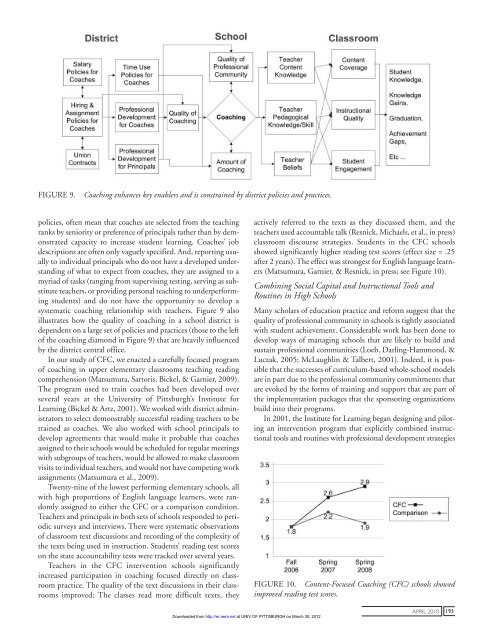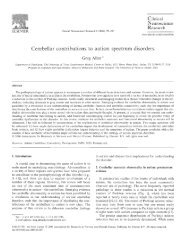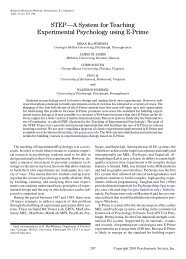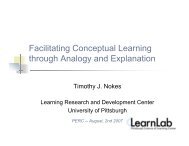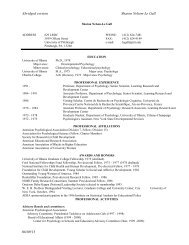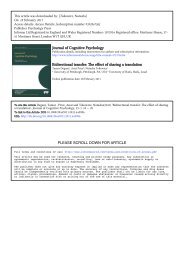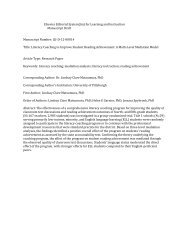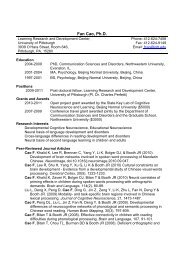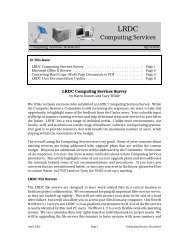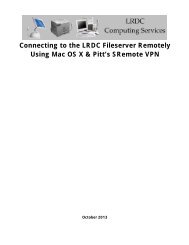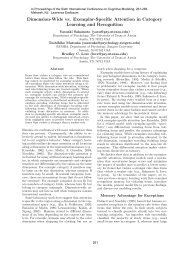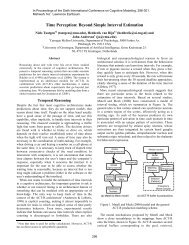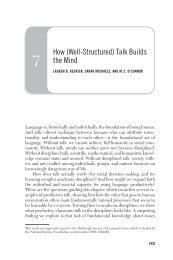Nested Learning Systems for the Thinking Curriculum
Nested Learning Systems for the Thinking Curriculum
Nested Learning Systems for the Thinking Curriculum
Create successful ePaper yourself
Turn your PDF publications into a flip-book with our unique Google optimized e-Paper software.
FIGURE 9. Coaching enhances key enablers and is constrained by district policies and practices.policies, often mean that coaches are selected from <strong>the</strong> teachingranks by seniority or preference of principals ra<strong>the</strong>r than by demonstratedcapacity to increase student learning. Coaches’ jobdescriptions are often only vaguely specified. And, reporting usuallyto individual principals who do not have a developed understandingof what to expect from coaches, <strong>the</strong>y are assigned to amyriad of tasks (ranging from supervising testing, serving as substituteteachers, or providing personal teaching to underper<strong>for</strong>mingstudents) and do not have <strong>the</strong> opportunity to develop asystematic coaching relationship with teachers. Figure 9 alsoillustrates how <strong>the</strong> quality of coaching in a school district isdependent on a large set of policies and practices (those to <strong>the</strong> leftof <strong>the</strong> coaching diamond in Figure 9) that are heavily influencedby <strong>the</strong> district central office.In our study of CFC, we enacted a carefully focused programof coaching in upper elementary classrooms teaching readingcomprehension (Matsumura, Sartoris, Bickel, & Garnier, 2009).The program used to train coaches had been developed overseveral years at <strong>the</strong> University of Pittsburgh’s Institute <strong>for</strong><strong>Learning</strong> (Bickel & Artz, 2001). We worked with district administratorsto select demonstrably successful reading teachers to betrained as coaches. We also worked with school principals todevelop agreements that would make it probable that coachesassigned to <strong>the</strong>ir schools would be scheduled <strong>for</strong> regular meetingswith subgroups of teachers, would be allowed to make classroomvisits to individual teachers, and would not have competing workassignments (Matsumura et al., 2009).Twenty-nine of <strong>the</strong> lowest per<strong>for</strong>ming elementary schools, allwith high proportions of English language learners, were randomlyassigned to ei<strong>the</strong>r <strong>the</strong> CFC or a comparison condition.Teachers and principals in both sets of schools responded to periodicsurveys and interviews. There were systematic observationsof classroom text discussions and recording of <strong>the</strong> complexity of<strong>the</strong> texts being used in instruction. Students’ reading test scoreson <strong>the</strong> state accountability tests were tracked over several years.Teachers in <strong>the</strong> CFC intervention schools significantlyincreased participation in coaching focused directly on classroompractice. The quality of <strong>the</strong> text discussions in <strong>the</strong>ir classroomsimproved: The classes read more difficult texts, <strong>the</strong>yactively referred to <strong>the</strong> texts as <strong>the</strong>y discussed <strong>the</strong>m, and <strong>the</strong>teachers used accountable talk (Resnick, Michaels, et al., in press)classroom discourse strategies. Students in <strong>the</strong> CFC schoolsshowed significantly higher reading test scores (effect size = .25after 2 years). The effect was strongest <strong>for</strong> English language learners(Matsumura, Garnier, & Resnick, in press; see Figure 10).Combining Social Capital and Instructional Tools andRoutines in High SchoolsMany scholars of education practice and re<strong>for</strong>m suggest that <strong>the</strong>quality of professional community in schools is tightly associatedwith student achievement. Considerable work has been done todevelop ways of managing schools that are likely to build andsustain professional communities (Loeb, Darling-Hammond, &Luczak, 2005; McLaughlin & Talbert, 2001). Indeed, it is possiblethat <strong>the</strong> successes of curriculum-based whole-school modelsare in part due to <strong>the</strong> professional community commitments thatare evoked by <strong>the</strong> <strong>for</strong>ms of training and support that are part of<strong>the</strong> implementation packages that <strong>the</strong> sponsoring organizationsbuild into <strong>the</strong>ir programs.In 2001, <strong>the</strong> Institute <strong>for</strong> <strong>Learning</strong> began designing and pilotingan intervention program that explicitly combined instructionaltools and routines with professional development strategiesFIGURE 10. Content-Focused Coaching (CFC) schools showedimproved reading test scores.Downloaded from http://er.aera.net at UNIV OF PITTSBURGH on March 30, 2012april 2010 193


